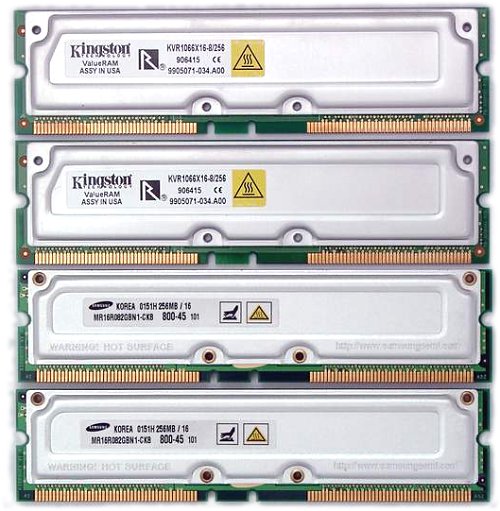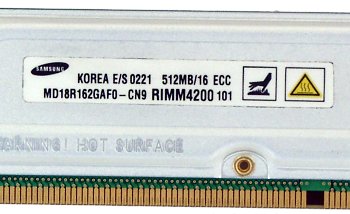 |
||
|
||
| ||
The dominance of the DDR memory standard which has the best support in the today's industry (at least, regarding the number of products) can create an impression that RDRAM will soon sink into oblivion. But in reality the standard is developing, and lately we got three new versions of Rambus DRAM - PC1066, PC3200 and PC4200. What do they differ from each other and from PC600 and PC800? The simplest way to learn the genealogy of the new models is to describe the differences from the old solutions. So, PC800 was a 16-bit memory model working at the actual frequency of 400 MHz (with the DDR equivalent of the bandwidth equal to 800 MHz). PC1066 is, roughly, the same PC800, only working at 533 MHz (1066 DDR MHz). PC3200 is based on the PC800 but instead of 16bit bus it has a 32bit one. PC4200 is a synthesis of two previous solutions - 533 MHz + 32bit bus. The fact that they used the frequencies in the marking (PC800/1066) in one case and the maximum theoretical throughput in MB/s (PC3200/4200) in the other is quite confusing, but it was the DDR memory that set that fashion (PC1600/2100/2700), and RDRAM just switched to this trend. Note that the Rambus doesn't offer anything cardinally new; it just increases its frequency and memory bus. Here are the modules of PC800 (two lower) and PC1066 (two upper):  As you can see, the the modules are identical (except the marking) and their connectors are physically compatible. In contrast, the 32bit PC3200/4200 memory can't be inserted in boards of the old standard. Below you can see the PC4200 module, and PC3200 looks exactly the same.   Mind the differences - first of all, the number of pins is greater (well, the bus has become twice wider), secondly, one of the cutouts has disappeared. It doesn't let install PC3200/4200 memory into old boards designed for PC800 (as well as into new ones meant for PC1066). The third change is that the cut in the PC3200/4200 is wider, that is why jut on the connector the module is inserted into is wider as well. That is why you can insert PC800/PC1066 into the board supporting 32bit RDRAM modules as the jut won't go into a narrow cut on such modules. Remember that if PC800/1066 RDRAM doesn't go into a newly bought board, it doesn't mean that it's just a factory defect and you can correct it with a file :). The 32-bit RDRAM has one more peculiarity - now the modules can be installed not only in pairs, but also singly. Well, it's quite logical - 16bit modules needed a pair to get 32 bits, which are already provided by PC3200/4200. Now the tests. First of all, let's see what testbeds and software we used, as well as mainboards which served the base for our test stands. Testbed:
Software:
Test resultsWstream and CachememWell, it's clear that low-level tests which emulate a pure hypothetic situation of 100% load of the memory controller with requests for stream reading or writing excellently demonstrate the theoretical advantages of the new fast memory over the old slow one. However, these results are not useless because they show the performance growth of the given subsystem. But don't take them to heart - synthetics will be synthetics. We can also put it this way: here we can see how efficient the PC4200/1066 is in comparison with its competitors in an ideal situation. CPU RightMark 1.01In this test our benchmark has justified its title of the test for estimation of CPU efficiency. The results are so harmonious and identical that I want thank our programmers a lot because they managed to develop a tool which can show on any system exactly what it should: potential efficiency of a given CPU. Regarding the memory, there is almost no spread in values, and in this case it's rather "pro" of the test than "con" of the test technique. Well, after this demonstration we will hardly include results of the CPU RM into the tests measuring efficiency of a memory subsystem. WAV-to-MP3, VideoCD-to-MPEG4Quite moderate scores, the systems go on a par. I assume that the size of simultaneously processed data in case of compression into these formats is not great; as for processing the whole stream (big in size), the speed is limited rather by the disc subsystem than by the memory efficiency. WinAce, 4 MB dictionaryThis is also a compression program, but look how strongly the large volume of simultaneously processed data tells upon the speed of different configurations! WinAce is undoubtedly one of the best high-level tests of memory performance. It's a pity though that the details of operation of multiple other compression and/or archiving programs are not available for us - quite often it's difficult to know how a certain compressor packs, which dictionary it uses and to what extent the increased RAM can affect its operation. SYSmark 2002The scores are moderate - there is some advantage but not great. An incentive to get the fast memory for applications of the class of the SYSmark is typical not of potential modernizers but of those who buy new systems. 3ds max 4.26Once we already made a supposition how rendering in 3ds max is accomplished on the code implementation level. The program is said to divide processed data automatically into fragments which can be placed in the CPU's L2 cache and only after that it processes such fragments. Without the sources we can't say whether this supposition is true or not, but, at least, the test results do not disprove it - the 3ds max is quite tolerant to the memory system speed. SPEC Viewperf 6.1.2The memory speed is ignored actually in all tests except AWadvs (Alias|Wavewfront Advanced Visualizer). The latter is known to be mad on AGP texturing, that is why it was easy to predict its reaction. On the whole, the rendering cores of professional OpenGL applications has quite a conservative reaction to the fast memory subsystem. SPEC Viewperf 7.0Here are already two applications which have a good reaction to the accelerated operation with RAM. It's not accidental that these applications are of the new wave which were not included into the old Viewperf 6.1.2 - Design Review and ProENGINEER. It proves the suggestion that modern software which accounts for new trends on the hardware market must be more sensitive to the memory bandwidth. 3DMark 2001There is some benefit from the faster memory but it's not so tangible so that we can recommend this upgrade type for owners of systems with slower RAM. These results can urge those who don't have a computer yet to buy a system with PC4200/1066 RDRAM. The difference between the 32 and 16 bit modules is almost zero. RtCW, Serious Sam, DroneZmarkIt looks the same everywhere - perfect scores in 640x480x16 (or 800x600x16) and sad performance in 1024x768x32. Well, in lower resolutions the CPU part is more important whole at higher resolutions more and more load is laid on the video card. By the way, this is one more splendid myth - a big advantage the games get from fast memory. The most impressive results are as a rule obtained in low resolutions :). I can't say there is no gain at all, but let's be more realistix PC4200 (32-bit) vs. PC1066 (16-bit), and PC3200 vs. PC800However strange it may be (from the theoretical standpoint), they do differ. Not much, but sometimes considerably. Let's look at the bottom of it. So, what can a one-channel 32-bit module be better in than a dual-channel one which are theoretically equal in performance? Well, the answer is in the number of channels. A twice wider bus gives more freedom for all participants in motion than two narrow channels. But don't disregard one more aspect - with the increasing demand for Rambus DRAM the products meant for it have become developing much faster. Can we suppose that the later boards designed for PC3200/4200 differ from earlier 16bit solutions only in the support of the new memory type, or the tuning process for a higher performance is much deeper? We will hardly ever find it out, but still... Nothing prevents us from making such an assumption. General conclusionUndoubtedly, PC4200 is the fastest memory of the RDRAM standard for today. PC3200 is a little bit quicker than PC800, but it concerns only the ASUS mainboards. So, if you are buying a new system and there is no price difference (or it's inconsiderable) between the machines based on PC4200 and PC1066 (PC3200 and PC800) then why to take a less efficient one? But if you are going to upgrade your system, I don't think it's the right time. To sell a board for PC800, to buy one for PC4200, to sell memory, to buy memory... The computer stands idle, money are flying away, the gain is 10% at best... Well, I would recommend to replace PC800 with PC4200 only for fans or rich people who get used to satisfying their every whim. As for the Rambus DRAM memory, Rambus made a couple of not very pleasant
things, and its marketing policy did no good either for the industry or
for Rambus. But how does it refer to RDRAM? Well, this is the fastest memory
in the x86 segment (in terms of the utmost achievements of each standard).
Taking into account the tendency to its falling in price and increase in
the production volumes, as well as the fact that Intel acknowledged this
standard (PC1066), I see no signs of RDRAM's vanishing away.
Write a comment below. No registration needed!
|
Platform · Video · Multimedia · Mobile · Other || About us & Privacy policy · Twitter · Facebook Copyright © Byrds Research & Publishing, Ltd., 1997–2011. All rights reserved. |